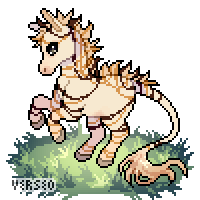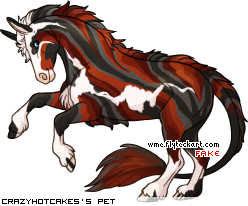
Links - Links - Links - Links
Species History
The Xanthos Equines are a fearsome mountain-dwelling species, broad of body and built for combat. Standing taller and heavier than most equines, their silhouettes are unmistakable—jagged spines rise along their back and shoulders, and their jaws hold long, curved teeth meant for both intimidation and combat.
Their lineage traces back to when shifting glaciers and relentless mountain storms reshaped the highlands. Ordinary horses that strayed into these ranges could not endure the predators, thin air, and constant rockfalls. Over centuries, the survivors became something else: larger, more muscular, and armed with natural defenses. Their spines evolved as shields against ambush predators and as weapons in brutal clashes between rivals, while their teeth adapted to tear through tough alpine scrub—and, when threatened, a means of defense.
Early mountain tribes told stories of them as the Thunderbacks, said to be born from lightning striking stone. Carvings in cliffside shrines depict them as guardians of high passes, both feared and revered. Some cultures believed that the spirits of warriors were reborn as Xanthos stallions, forever roaming the ridges.
The species resisted every attempt at domestication. Too wild, too proud, too dangerous—they fight to the death rather than submit. Their herds move with the weather, vanishing into mists and crags, led by dominant stallions whose spines are often broken or scarred from countless battles.
Until now, it is unknown what has caused this change but a few brave explores and warriors have managed to tame these fearsome beasts.
Notable Features
- All Xanthos Equines have long canine teeth, spines on their shoulders and back. Some do grow additional spines along their backs, rumps and tails. Spines come in all verity of color, both neutral and vivid. Their eyes can also be any color.
- Males always have slightly fuller tails and tend to be slightly larger than their female counter parts.
- Tall and thick bodied they range in height between 16hh and 20hh.
- Some Xanthos have additional horns, these are less common. The horns can come in many shapes and verities.
- Xanthos Equines mostly follow typical horse genetic, however their coat colors can be a bit more vivid in color and they come in significantly more verity of pattern than typical horses. Along with the standard patterns, they can have deer-like spots or outlined spots similar to what you see on some cats. They can also have stripes and large splotches.
- Their skin is a grey-blue or grey-purple rather than the black or pink, this can cause a blue or purple tinge under white hair, particularly around the nose and eyes and under their legs.














